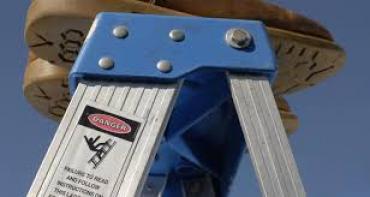HSE stats confirm farming as UK's most dangerous sector
6th Jul 2017 / By Alistair Driver
Figures released by the Health and Safety Executive (HSE) have confirmed agriculture as the most dangerous industry in the UK.
 A total of 27 fatal injuries to agricultural workers were recorded in 2016, a a marginal improvement on 2015. However, this cannot mask the fact that fatal injury rates far outstrip all other occupations, with workers in farming 18 times more likely to die at work than the overall industry rate.
A total of 27 fatal injuries to agricultural workers were recorded in 2016, a a marginal improvement on 2015. However, this cannot mask the fact that fatal injury rates far outstrip all other occupations, with workers in farming 18 times more likely to die at work than the overall industry rate.
Construction is the next most dangerous occupation, but it has rates of fatal injuries four times higher than the overall industry rate, a figure far lower than agriculture.
he new figures also highlight the risks to older workers – around a quarter of fatal injuries in 2016/17 were to workers aged 60 or over, even though such workers made up only around 10% of the workforce.
Producer group
Farm safety was one of the main topics at the latest NPA producer group meeting in June when the NFU’s chief farm safety adviser, Tom Price, spoke to the group about the industry’s ongoing failure to improve its record.
The industry’s age profile, regular work with heavy machinery, a tendency for farmers to work in isolation and an ‘always-done-it-that-way’ attitude were all highlighted as factors. Increasing awareness of the risks and the deployment of peer pressure to change attitudes were identified as part of the solution.
NPA chairman Richard Lister said: “This is a very sobering set of figures for the whole of the agricultural industry.
“I think as producers, owners and managers, we all have to consider if we are doing everything within our control to avoid the prospect of accidents occurring. The involvement of all staff in this process will be key to affecting change and enabling us to create a safe working environment.”
To see the feature on farm safety that appeared in the July edition of Pig World, click here.
This includes comments by Robin Simon, health & safety, environmental and welfare manager at Wayland Farms, who said all staff are encouraged to ‘stop and think’ before undertaking a task, and to ring a manager to discuss how to proceed.
“All staff are trained for working at height and in manual handling, all are trained on telehandlers and we are now catching up on tractor training, and at least half our staff have had training in health & safety awareness,” he said.
NFU vice president, and chairman of the Farm Safety Partnership, Guy Smith, said: “Safety should be a priority for all British farmers and we are encouraged by the measures that our members are taking to assess risks.”
Preventable accidents
Although accidents can happen, even with the best precautions and risk management plans in place, all too often those that occur in agriculture are preventable.
Vehicle accidents are a good example. “In the last 10 years, 36 of the 98 vehicle fatalities were caused by the operator being run over by his own vehicle,” Mr Price said. These 36 lives could very likely have been saved, he added, by following the ‘safe stop’ procedure of:
- Handbrake on
- Controls in neutral
- Engine off
- Key out
“The starting point to improve the industry’s record is to look critically at the business and to conduct a thorough risk assessment,” said Mr Price. A risk assessment need not be a difficult exercise – it is all about thinking what might cause harm to people and then taking reasonable steps to prevent the harm, he added. Lone working is one example of a risk. Ways to manage it might include:
- Letting other people know when and where a person might be working alone
- Keeping in touch by mobile or two-way radio
- Agreeing times to report back in
The HSE’s website has information about risk management, including a risk assessment template.